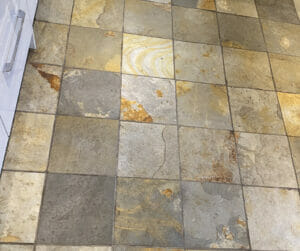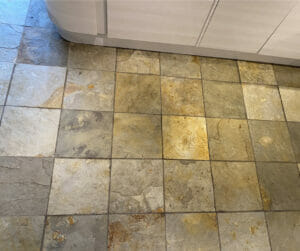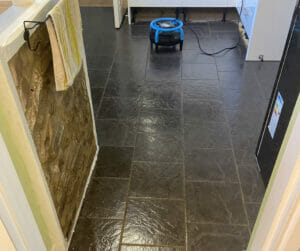There are many types of stone floors and if you've landed here you probably have a slate stone floor or you're thinking about having a slate stone floor installed.
Slate flooring may be as "hard as a rock", but it does need regular cleaning to look its best. You can use many common cleaners and cleaning tools on a slate floor, and some you should never use. When it comes to cleaning, a household cleaner usually does the trick. However, while regular cleaning is essential for preventing undue wear and tear and the way it looks, sealing the slate is the best way to protect this porous stone from everyday dirt and stains. ( and grout joints)

So, the answer to your question is yes… you can clean your slate stone floor… Slate floor cleaning can be a tough job, but once it’s been done it looks so beautiful.
The best thing you can do to look after a slate floor is to keep it clear of debris and loose dirt. These particles can act like the grits on sandpaper… which, as people walk on it, will wear down the protective sealer and make scratches in the tiles. You can clean slate floors regularly with a broom, dust mop, and a damp mop. Ideally, it would help if you dust your slate floor daily and mop with a damp mop once a week. Most slate manufacturers recommend applying a sealer every three to five years.




Never use abrasive or acidic cleaning products when spot-cleaning stains or mopping a slate stone floor. Acidic cleaners, including ordinary vinegar, have a chemical reaction that can etch the slate. The more potent cleaning agents can strip the sealer on your slate and grout.
Also, never use dust-mop treatment or soil-based cleaners. Oils will make the floors slippery and clog up the textured surface and crevices of the stone.
I will start with DIY and how you can clean your slate stone floor and then at the end there is another blog showing you what we do.
Dust mop the whole floor with a machine-washable, high-quality dust mop. Start at one end and push the mop toward the other end… use the same motion for the whole floor. Do not to move the mop back and forth because it will simply spread around the grit and dirt. Work in sections at a time, and sweep up the accumulated dirt and grit line before moving on to the next area.
With a damp mop, mop the floor. We recommend mopping with a high-quality washable mop and plain water. Occasionally deep clean with a few drops of mild detergent… like washing up liquid or delicate fabric detergent for soft fabrics. If you use anything in the water, rinse the floor thoroughly with plain water. And do not let large puddles form or leave water on the surface for too long. Allow your floor to dry completely before walking on it.
Removing stains on your slate stone floor isn’t easy… in fact removing stains on any stone floor isn’t easy as you can do damage if your not sure what you’re doing. You can use ordinary isopropyl rubbing alcohol and water to spot-treat stains. Mix 1 quart of water with 1/2 cup of alcohol. Use a sponge to wipe the stain. If needed, scrub the stain with a cloth or towel.
If the slate floor has been waxed or has traces of an old sealant, you will need a chemical stripper to clean the surface of your floor. You can remove the wax with a wax stripper. However, do this carefully, so you don’t damage the floor. Other types of sealers, such as urethane or acrylic coatings, will require a more potent solvent stripper… but we advise leaving this to a restoration or stone floor professional.
Pick a sealer based on the amount of traffic the floor gets, the type of slate you have, and the desired look of the slate floor.
On a slate floor, you can use two types of sealant:
Penetrating sealers have a less visible finish compared to surface sealers. However, because penetrating sealers leave the slate looking natural, homeowners generally prefer them.
Make sure the floor is spotless and dry. Pour a small amount of penetrating sealer into a plastic tub. Swish the sealer gently so it coats the tub, and tip it, so the sealer goes to one side… Dip your sponge into the bottom of the pot, keeping it away from the pool of sealer that’s on one side… add a thin layer of sealer to the sponge.
Rub the sponge over the grout and tiles back and forth and in circular motions to cover the whole surface. Work in small areas and leave the sealer to sit for five minutes or as directed by the instructions on your sealer.
Immediately buff the sealed area with a towel or clean cotton cloth. This action will work the sealer into the grout and tile and help remove any sealer left from the floor. Repeat the process of applying the sealer, leaving it to sit, and then buffing it to seal the entire slate floor. They recommend you overlap each section onto the section before so the wet sealer blends with the previous sections.
If needed, apply another coat of sealer after the first is completely dry.
How do professionals clean tiled floors?
Stone floor Restoration: How do we know how?
 Written and edited by Tracey Gilbey, Marketing and Admin Coordinator at Art of Clean.
Written and edited by Tracey Gilbey, Marketing and Admin Coordinator at Art of Clean.
For further advice or information on our Carpet and Soft Furnishing care, please do not hesitate to contact the Art of Clean team on 01223 901551 in Cambridge. Our services include Carpet Cleaning, Upholstery Cleaning, oriental and area Rug Cleaning, Curtain Cleaning, Patio, and Driveway Pressure washing, Leather Cleaning, Stone and Tile Floor Cleaning, and Wood Floor Sanding and Restoration. We also supply new flooring and carpets through our sister company Art of Flooring. Our Dry-Cleaning service is provided by Farthings Cambridge

For further advice or information on our Carpet and Soft Furnishing care, please do not hesitate to contact the Art of Clean team on 01223 901551 in Cambridge. Our services include Carpet Cleaning, Upholstery Cleaning, oriental and area Rug Cleaning, Curtain Cleaning, Patio, and Driveway Pressure washing, Leather Cleaning, Stone and Tile Floor Cleaning, and Wood Floor Sanding and Restoration. We also supply new flooring and carpets through our sister company Art of Flooring. Farthings Cambridge provides our Dry-Cleaning service